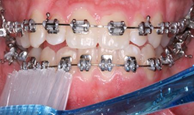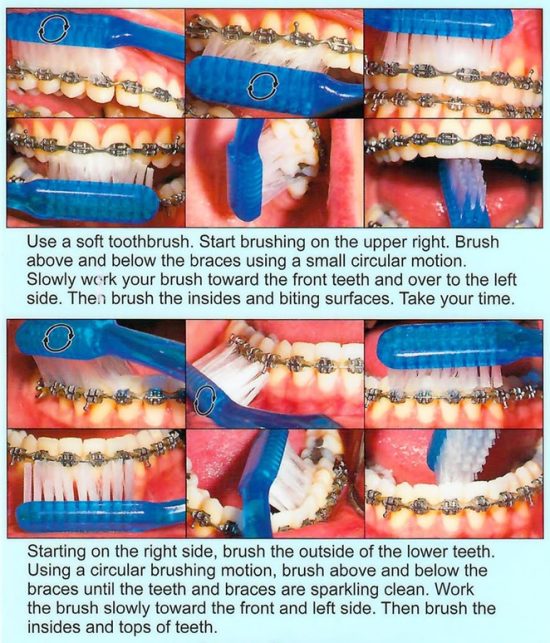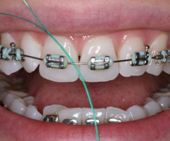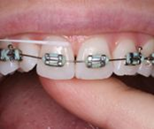Brushing and Flossing
At the completion of orthodontic treatment, how spectacular your smile appears depends partly on how healthy your teeth and gums are. The teeth will be straight, but swollen gums and decalcification (white spots) will negatively affect the brilliance of your new smile. Proper brushing and flossing throughout treatment can help prevent gingivitis and decalcification.
Brushing
Brush your teeth at least twice a day (especially before going to bed at night) with an approved soft bristle brush and toothpaste.
- Place the toothbrush at a 45 degree angle to the gums and gently brush using a small, circular motion, ensuring that you always feel the bristles on the gums.
- Brush all surfaces of the teeth (outer, inner, and biting surfaces of each tooth)
- Angle the toothbrush such that you can use the tip of the brush to clean the inside of the front teeth.
- Don’t forget your tongue! Brush your tongue to remove bacteria and freshen your breath.

Electric toothbrushes are also useful. They are easy to use and can remove plaque efficiently. However, they still need to
contact the teeth and gums at the same angles and reach all the surfaces of the teeth as if a manual toothbrush would. Place the bristles of the electric brush on your gums and teeth and allow the brush to oscillate, thereby removing the plaque and debris. Make sure the bristles of the electric brush are getting in behind the wire.

Flossing
Daily flossing is the best way to clean between the teeth and under the gumline. Flossing not only helps clean these spaces, but it disrupts plaque colonies from building up, thereby preventing damage to the gums, teeth, and bone.
- Take 12-16 inches (30-40cm) of dental floss and tread it into a floss threader. Tie it on if you prefer.
- Thread the floss under the wire between the teeth
- Once the floss is under your wire, use your thumbs and forefingers to guide the floss to gently insert the floss between teeth.
- Curve the floss into a “C” shape around each tooth and under the gumline. Gently move the floss up and down, cleaning the side of each tooth.
Floss holders are recommended if you have difficulty using conventional floss.


Rinsing
It is important to rinse your mouth with water following every meal to remove food debris, especially if you are unable to brush after each meal.
If you are using an over-the-counter product for rinsing or disclosing plaque, it’s a good idea to consult with your dentist or dental hygienist on its appropriateness for you.
Use other dental aids as recommended by your dentist or dental hygienist can help you maintain proper dental health. These may include interdental brushes, rubber tip stimulators, tongue cleaners, irrigation devices, fluoride, and medicated rinses.
Book a Consultation
Get started today by calling us at (604) 474-1141, or by booking a consultation.
During your initial consultation, we will understand your situation, perform a visual examination of your bite, recommend a treatment plan and answer any questions or concerns you may have.
Innova Orthodontics
Monday
Closed
Tuesday
10:00am – 6:00pm
Wednesday
8:30am – 5:00pm
Thursday
8:30am – 5:00pm
Friday
7:30am – 3:00pm